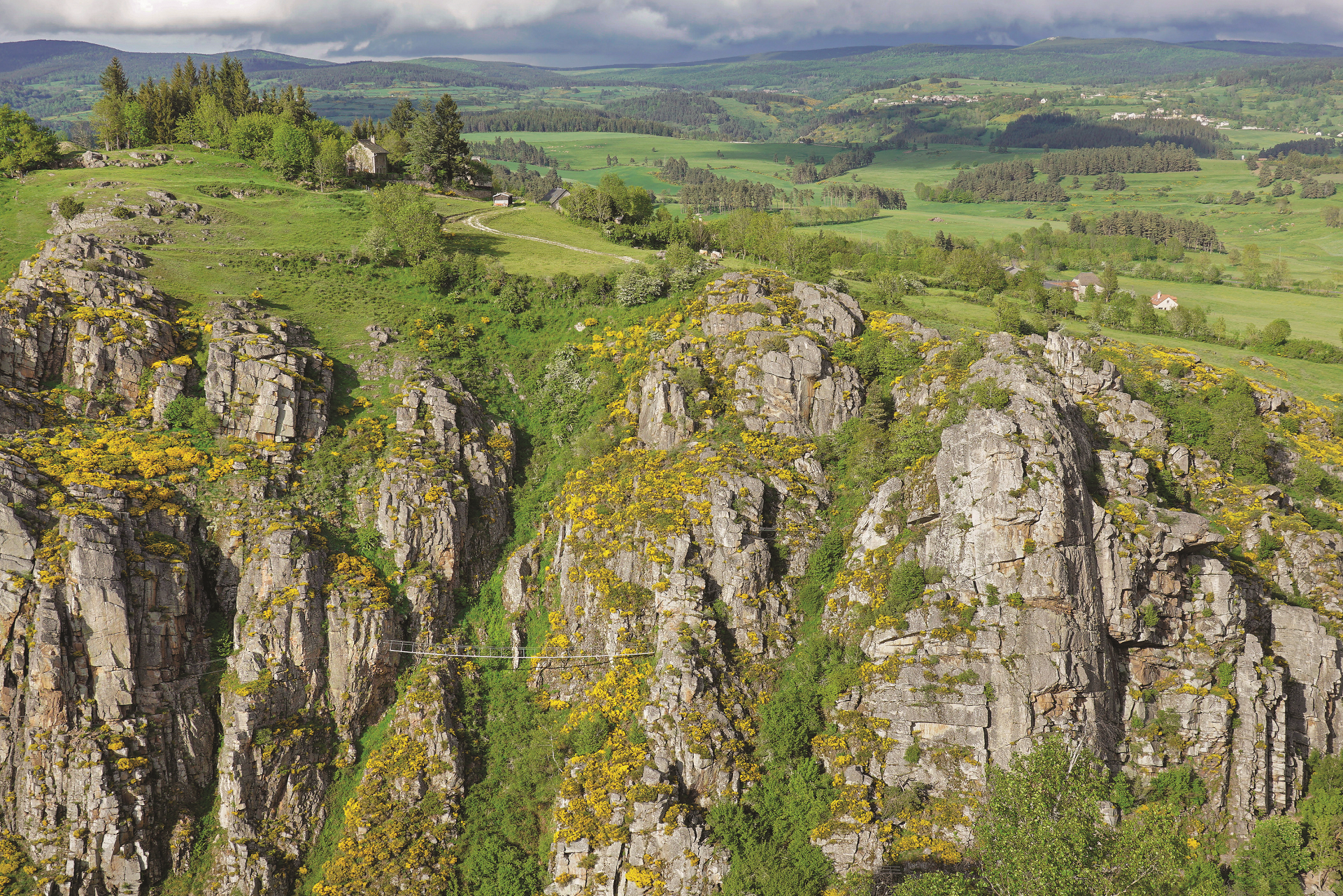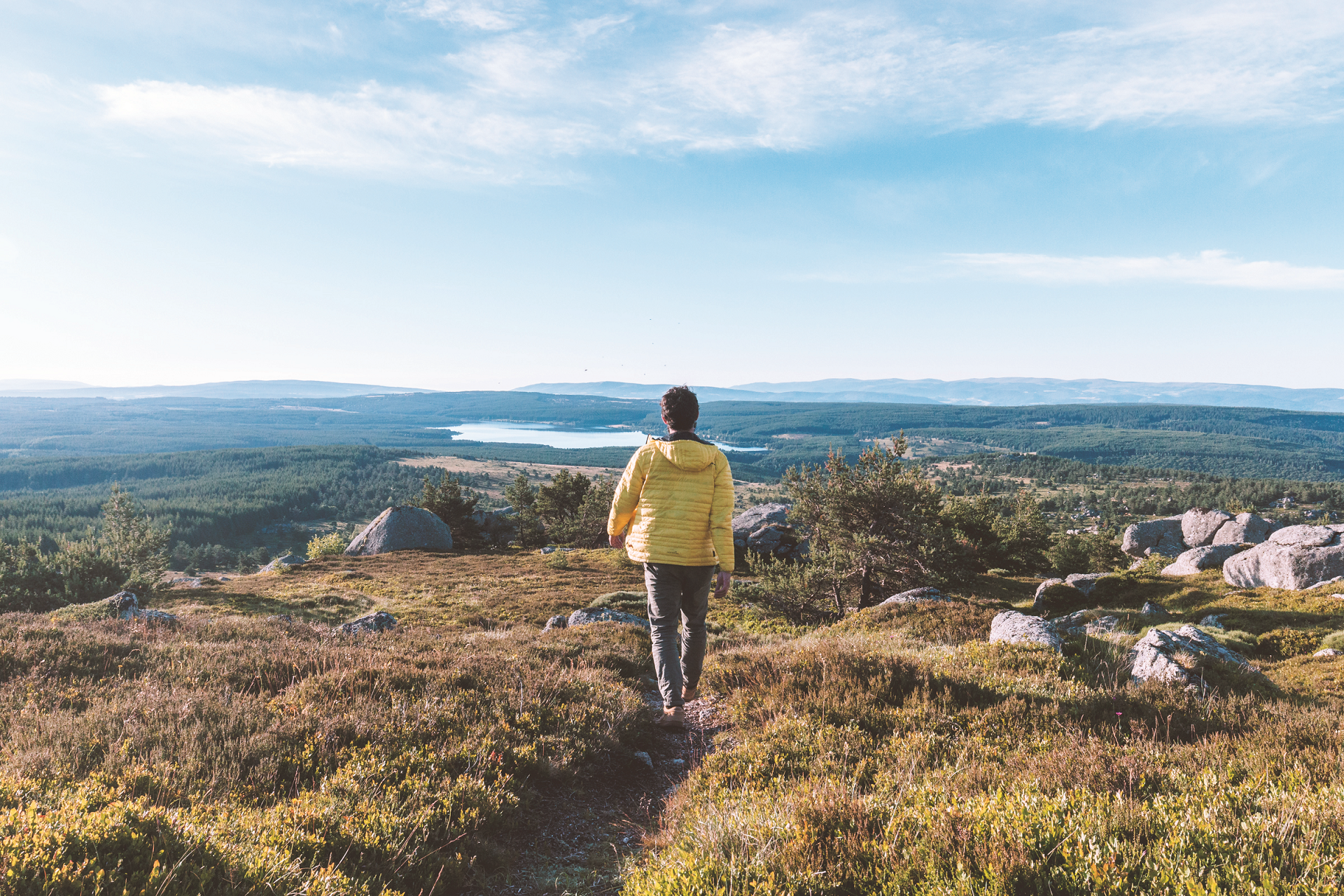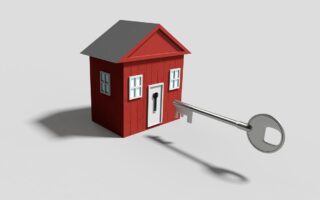French Location Guide: La Margeride

Carolyn Reynier explores La Margeride, a scenic and tranquil corner of Lozère…
I want to take you to a wild and secret location in Lozère in the Occitanie region. Its population may be the lowest in France, but all of the 430-plus rivers flowing through Lozère -including the Tarn, Lot and Allier-rise in the department. Not for nothing is it known as the Pays des Sources.
The Margeride, in the northeast, is an area of immense plains and high granite plateaux, wooded and eroded expanses of heathland and pines, flowing rivers and sparkling lakes, all scented with the mossy fragrance of its forests. The 1,050-hectare Lac de Naussac offers beaches and a variety of water activities, as do other smaller lakes. There’s great hiking, cycling and mountain biking, as well as excellent river and lake fishing and kayaking, and if enough snow falls, you can explore the area on skis too.
We’ll look at property in and around Langogne, with its circular medieval town centre, on the border with Haute-Loire and Ardeche: Châteauneuf- de-Randon perched on a rocky promontory; and Le Malzieu- Ville, one of the Plus Beaux Villages de France on the banks of the Truyère river.
I spoke to Ingrid Trioulier at the Agence Immobilière Langonaise at Langogne. This little town lies at the crossroads of three departments, so her sector covers the Margeride and also parts of Haute-Loire to the north, and Ardèche to the east. Langogne is on the N88 Lyon-Toulouse main road. halfway between Haute-Loire prefecture Le Puy-en-Velay to the north and Lozère prefecture Mende to the southwest.
CENTRAL LOCATION
“If you prefer to be in town and get everywhere on foot, there are small, tall (one room per floor), stone terraced houses available. Properties in the Rue Haute, which starts in the heart of the old town, often have a small rear garden,” she says.
You could pick up a house for restoration for about £40,000; expect to pay £160,000- €170,000 for a renovated one. If you buy in the old town centre and want to do work, you’ll need to consult the Bâtiments de France architect.
Some old houses have been converted and offer 40m²-50m independent apartments on each floor, she adds. However, they rarely come to market because investors often buy the entire building and let out the apartments for rental income. “In any case,” says Ingrid, “people in these parts tend to purchase houses rather than apartments because both property and building land are inexpensive.”
If you’ve set your heart on building your own home, you can buy a plot of around 700m for about £40,000 in housing estates on the outskirts of Langogne; if you haven’t, you can snap up a modem three- bedroom villa for €200,000 just a short walk from the shops.
In surrounding hamlets, each sector has its own clientele. “We have clients who’ll want the Côté Andechois, others who will only want Haute-Loire or the Margeride,” she says. This is the Massif Central, so although landscapes vary, they remain similar-as does the architecture. The main type of construction is the corps de ferme built in local granite or volcanic rock. People love old farmsteads either to renovate, or already renovated with large living areas of 90m-100m or more, created in former stables and barns. Livestock kept in days of yore included cows, sheep, pigs and horses. Today in the Margeride you’ll also find camels. An ambitious farmer at Auroux near Lac de Naussac sells soap and other produce made from camels’ milk.

©Reynier
These farmsteads, be they small or large, are much in demand. People are looking for space, authenticity, a change of scene (dépaysement), to recharge their batteries (se ressourcer) two useful terms you’ll often hear. “The old farmstead with its cantou, a monumental stone fireplace with rustic benches within its surrounds where rural familles congregated in earlier times, that’s what people are looking for,” says Ingrid. In Lozère, the stone will be granite, in Haute- Loire, volcanic as you approach the Auvergne volcanoes.
Expect to pay in the region of €230.000-€250,000 for a farmstead that has been recently and sympathetically renovated-for example, retaining the exposed stonework and conserving the original wooden beams. If you want to do it yourself, you’ll pay around €20,000-€30,000 to buy “four walls”. Then give free rein to your imagination to convert stables into spacious living rooms, and barn doors into French windows with living quarters behind. “There is enormous potential in these properties,” says Ingrid.)
You may want to create chambres d’hôte or gite accommodation for walkers along two famous hiking paths nearby. Robert Louis Stevenson, on his travels in the Cévennes with his donkey, Modestine, passed through Langogne along what is today the GR70 (grande nandonnée, long-distance hiking path).

©Reynier
PILGRIM ROUTES
Pilgrims follow the Way of Saint James, which traverses the Margeride through St-Alban- sur-Limagnole on the 1.530km- long Via Podiensis. This starts at Le Puy-en-Velay and is one of the four major routes to Santiago de Compostela in northwest Spain. In a nearby hamlet, an old stone renovated farmstead is on the market for €270,000. You get six bedrooms, attic for conversion, enclosed grounds with fruit trees, private water supply and an “exceptional” view (Beatrice Borie, Efficity).
Ingrid hails from Grandrieu, northwest of Langogne. The canton is traversed by the Via Agrippa; the highest point is the Roc de Fenestre at an altitude of 1,486m. There has been much development here over the past few years.
GENERATION GAIN
“The village, like so many others, has seen young people leave but some of the current generation are staying,” Ingrid says, quoting the example of a youngster staying in the village to replace the electrician, who is retiring. Numerous associations provide activities for all ages and are supported by second-home owners who live for six months on the Mediterranean coast and six months in Lozère to escape the heat. Prices here are around half those of Langogne. It is away from the main roads “but it’s a very pretty hamlet”.
To the south, Châteauneuf- de-Randon with its tall stone houses and historic centre was built on the site of a Gallo- Roman village. The remains of the Tour des Anglais testify to the English occupation in 1360 during the Hundred Years’ War. Its strategic location near the N88 Lyon-Toulouse main road, halfway between Mende and Langogne, makes it an ideal place to build or buy for people working in either place. There’s an old Margeride farm for sale at €146,000 in a nearby hamlet, with two bedrooms, outbuildings and adjoining land (Agence la Lauze).
VILLAGE PROPERTIES
In the northwest of the Margeride, have a look at the attractive medieval village of Le Malzieu-Ville. You can buy a central south-facing 19th- century stone village house here, with four bedrooms and terrace, for €160,000. The first and second floors need freshening up, and there’s a large attic to convert (Béatrice Borie, Efficity).
You can still find properties for restoration, but Ingrid says the ‘Covid effect‘ has reduced their portfolio and today they struggle to meet demand. Potential clients now prefer to place their money in property, rather than keep it in the bank. “City dwellers want to get back to nature – and they all remember family holidays in the Lozère,” she says. Today, clients buy second homes with view to eventually retiring av here, and fibre-optic internet, la fibre, has arrived, encouraging remote-working (le télétravail).
The Margeride’s holiday season can bring in some rental income from May to September. “But investors often choose Langogne,” says Ingrid. “Here tenants are those who prefer to rent or can’t afford to buy, or students at the Ensemble Scolaire St Pierre-St Paul.”
It’s true that the Margeride is a wild and wonderful place and many villages and hamlets do not have shops. But there are Mende and Le Puy-en-Velay for major shopping trips, and various smaller towns with good amenities. For Ingrid, the great advantage of living here is the quality of life. The cost of living is lower than elsewhere, the roads are quiet and property is affordable.
“We’re only a couple of hours from Lyon, two and a half from Montpellier and the Mediterranean, and you can drive to ski resorts in the Alps in three hours,” she says.
Whether you’re kite surfing on Lac de Naussac, exploring the area on horseback, or cross- country skiing, the Margeride offers lots of lovely landscapes inhabited by very few people. Not perhaps the most accessible place- the nearest airports are at Rodez, Nimes, Montpellier, or there’s the A75 and A7-but it’s perfect if you’re looking for some peace and quiet. So let your imagination run wild and plan your new life in the Margeride.
Thinking of moving to France?
The unique mix of legal, financial and tax advice along with in-depth location guides, inspiring real life stories, the best properties on the market, entertaining regular pages and the latest property news and market reports makes French Property News magazine a must-buy publication for anyone serious about buying and owning a property in France.
Lead photo credit : ©Reynier
Share to: Facebook Twitter LinkedIn Email
More in Location guide, Occitanie
Leave a reply
Your email address will not be published. Required fields are marked *




